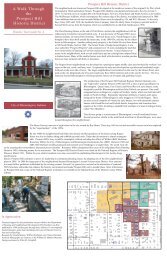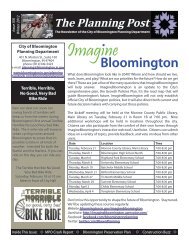Peak Oil Task Force Report - City of Bloomington - State of Indiana
Peak Oil Task Force Report - City of Bloomington - State of Indiana
Peak Oil Task Force Report - City of Bloomington - State of Indiana
Create successful ePaper yourself
Turn your PDF publications into a flip-book with our unique Google optimized e-Paper software.
Amend the Bicycle, Pedestrian and Greenways Plan to significantly increase the<br />
number <strong>of</strong> planned “lengthy corridors.”<br />
At present, the Plan only includes two substantial east‐west bicycle boulevards: the 6 th /7 th<br />
Street/Longview Avenue Bicycle Boulevard and the Allen Street/Covenanter Drive Bicycle<br />
Boulevard. While these boulevards are critical, alone they are insufficient to foster the<br />
kind <strong>of</strong> east‐west connectivity that is truly needed for bicycle riders in a post‐peak<br />
environment. The <strong>City</strong> should add more east‐west connective corridors by exploring<br />
options such as closing <strong>of</strong>f lanes or closing streets for automobile thru traffic and opening<br />
these streets up for bicycles, skateboards, pedestrians and other low‐speed traffic. Usually<br />
bicycle boulevards do not completely exclude cars, but limit them in some ways.<br />
Boulevards are most appropriate on roads which have slower speeds and less vehicular<br />
traffic. They are generally open to emergency vehicles.<br />
We encourage the <strong>City</strong> to pursue this option boldly. The post peak‐oil economy may strap<br />
<strong>City</strong> budgets <strong>of</strong> the means to pursue investments into more costly bicycle and pedestrian<br />
facilities, including multi‐use trails separate from roadways or separate side‐paths along<br />
arterials dedicated to bicycles. The <strong>City</strong> should therefore put the highest priority on<br />
conversion <strong>of</strong> existing streets (or lanes) to bicycle traffic, even along now busy arterials,<br />
keeping in mind that in a post‐peak future, automobile travel is likely to shrink, making this<br />
kind <strong>of</strong> conversion more feasible.<br />
In transitioning any road to accommodate bicycle traffic, the <strong>City</strong> should aim to narrow the<br />
lanes for car traffic as much as possible, ideally to nine feet in width. Such narrowing will<br />
help slow traffic speeds and make drivers more aware <strong>of</strong> bicyclists and pedestrians in<br />
addition to allowing a wider space for bicycle lanes. 173<br />
173 Dan Burden and Peter Lagerwey, Road Diets: Fixing the Big Roads, 1999, Walkable Communities,<br />
http://www.walkable.org/<br />
<strong>Report</strong> <strong>of</strong> the <strong>Bloomington</strong> <strong>Peak</strong> <strong>Oil</strong> <strong>Task</strong> <strong>Force</strong><br />
143









